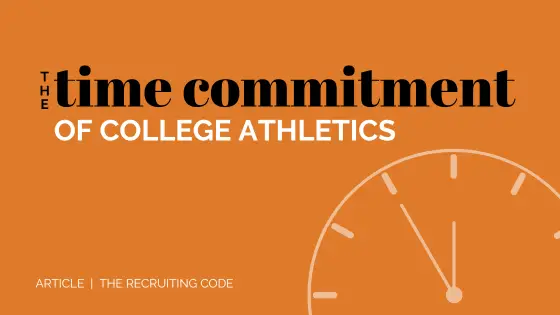In Season
Each sport varies in its time commitment. The in-season commitment is by far the most demanding in terms of time. As a general rule of thumb, during season, you should plan on focusing on your academics and athletics. Nothing else!
On training days, you should expect to train for 2 hours per day (unless you are a swimmer and then as you know, plan on learning to breath and study underwater). Many programs may also have a weight lifting or fitness component in addition to the training. If your athletic program has more than one session, one will generally be in the morning at about 6:00am. The other session will be in the afternoon or evening. Also consider the program’s travel schedule, you may be gone up to three days per trip, and game day commitments.
The Non-Traditional Season
The non-traditional season is the period outside of the regular season in which coaches are allowed to work with their athletes. All NCAA schools have non-traditional seasons. The length and intensity will vary quite a bit based on NCAA classification.
In Division 1 and 2, the time commitment in the non-traditional season is substantial, but is less than the traditional season.
Division 3 has very limited weeks in which they are allowed to train, approximately five weeks, depending upon the sport. This means that if you play a fall sport, during the spring you may only practice with a coach during five of the sixteen weeks in the semester.
NAIA schools are left to their own discretion of how much to train outside of the traditional season.
Summer Commitment
Summer is not off for college athletes. You should expect to be putting in ten to fifteen hours per week minimum during the summer to prepare yourself for the upcoming athletic season. College coaches are expecting you to come in physically prepared. Collegiate seasons are too short. If you show up and expect to get into shape at that point, you will get left behind.
The Commodity of Time
Athletes looking to play in college, must seriously contemplate the benefits and drawbacks of dedicating so much to sport. Let’s take a look at a few of them to consider. If you are an athlete, you have a strong desire to continue to play and compete at the next level. It is worth considering the implications of playing.
Minimum Wage
Collegiate athletics are very demanding on your time; what else could you do with your time? What if you got a minimum wage job for ten hours per week each semester? We will assume that during the winter break and summer break you can earn an equivalent amount whether or not you play sport. There are typically 16 weeks in a semester, subtract one for finals week and you have 15 weeks each semester or 30 weeks per school year. Currently the federal minimum wage is $7.25. $7.25 X 30 weeks X 10 hours per week = $2,175. So for those of you who accept an athletic scholarship for $2,000 or less, enjoy the sport. Also realize you are not paying your way through college on that scholarship. You are, in effect, giving up money and work experience to play the sport you love.
Do Academics Suffer?
Will academics suffer because of athletic commitments? This is difficult to answer, but not impossible. Most student-athletes who are driven to succeed can do so both on the field and in the classroom at the same time.
I coached college athletes for ten years at the NAIA and NCAA Division 3 levels. Every single year, our team GPA was higher during our season than it was the other semester. What this always told me was that in season, when it was necessary to be structured with their time, there was enough time.
During the non-traditional season, for us the spring semester, the student-athletes had more disposable time. Less structure and demand on their time caused many athletes to be slack in their academics. It never was a time issue, it was a dedication issue.
The academic success rate is the number of athletes who come in as freshmen and graduate within five years. In Division 1, 81% graduate, 71% of Division 2 graduate, and 87% of Division 3 graduate. These are high percentages compared to the general student population. Student athletes are dedicated people.
Athletics, depending upon the sport, the school and the classification (D1, 2, 3, NAIA) can interfere with which classes and how many credits can be taken. At the Division 3 level, a full academic load of 16-18 credits can be managed during season. At the Division 1 level and depending upon the team, 12-14 credits is normal. The difference can mean adding a fifth year of college to graduate. Again, ask up front and be willing to calculate this into your opportunity cost. This is one more year of expenses and one less year of income.
The Time Costs vs. The Rewards
There is no doubt college athletics take up an incredible amount of time. Is it worth it? Only you can answer that. I don’t think the answer is the same for everyone. It is definitely worth sitting down as a family and discussing it.
For me there are benefits that go beyond the athletic surface. I have dedicated my career to sport, so for me the answer has always been that the benefits outweigh the cost of time.
If you are ready for a step-by-step plan to take your talent to the next level and need someone to walk you through the process, let me guide you.
How to Get Recruited: Got Talent. Get a Plan. Get Recruited.
LIKE WHAT YOU READ?
Please take a moment to help out your friends and teammates, by clicking on the “sharing is caring” buttons below.
Thanks,
Bryan
P.S. Come join our Facebook group, The Recruiting Code. This is the place to be for parents and coaches to talk about college recruiting. Come learn from each other, share stories and get information that will help your child become a college athlete.




In the top-tier Division I, almost two of every three said they consider themselves more as athletes than students. That’s reflected in their time commitments, both required and voluntary.